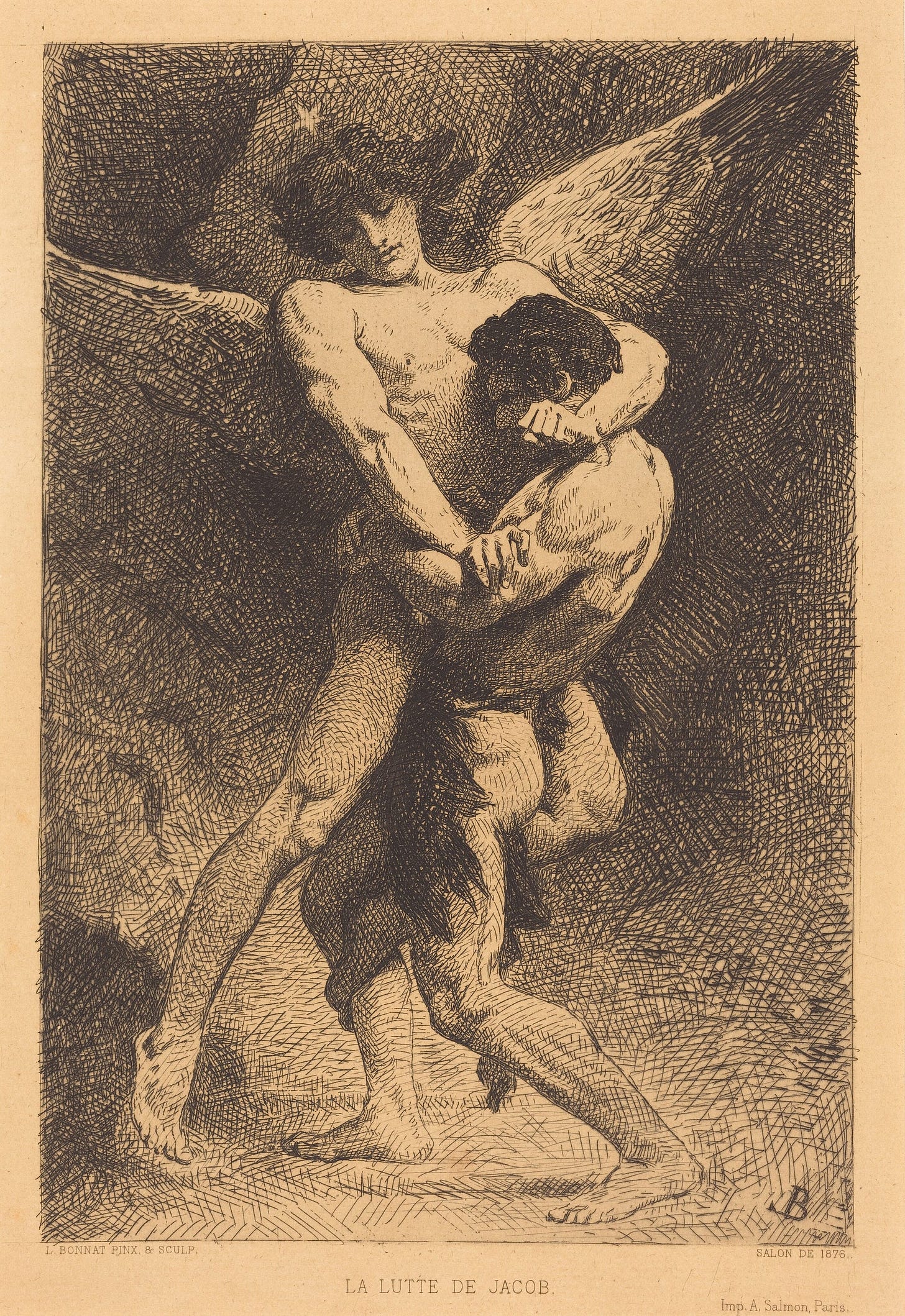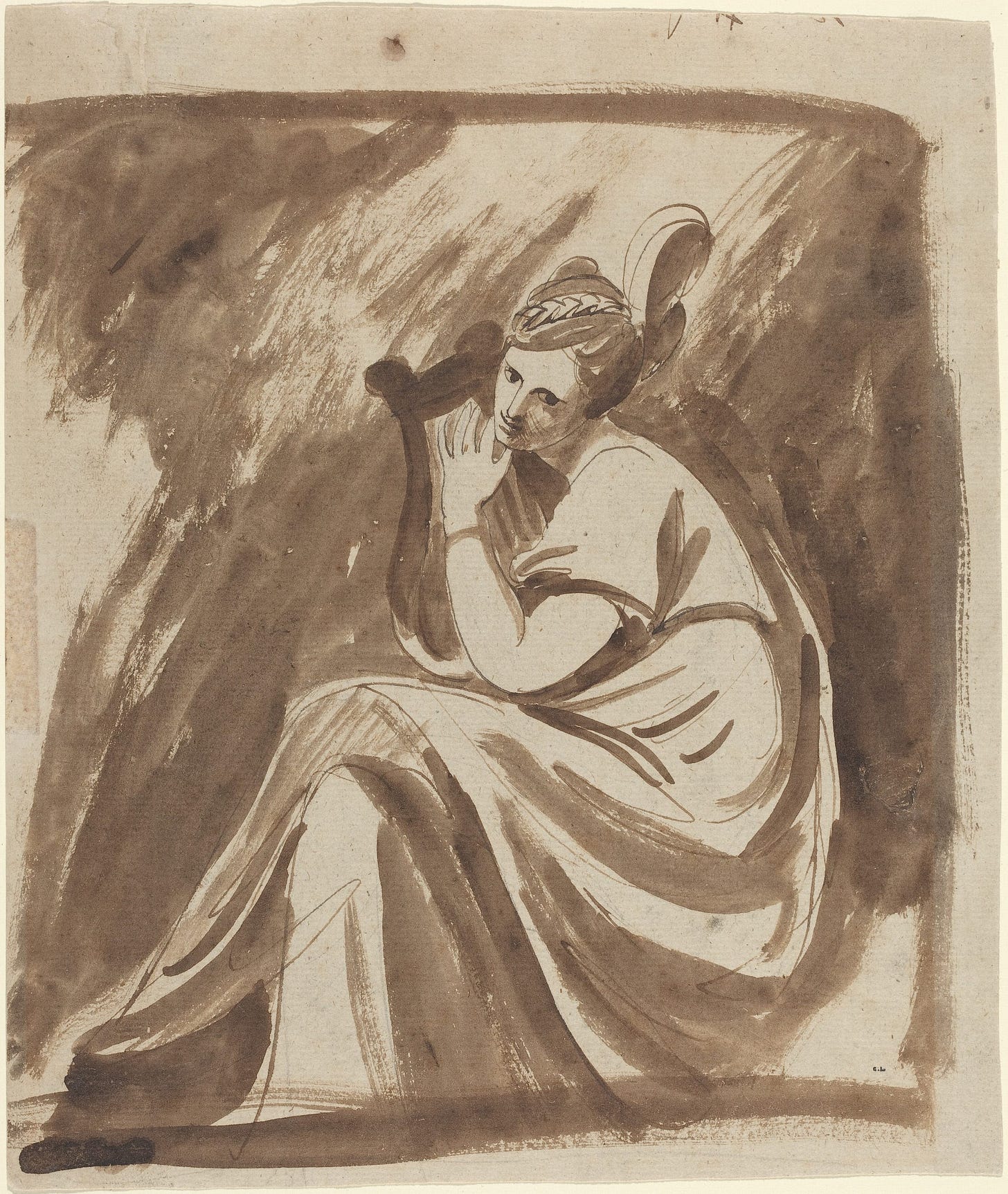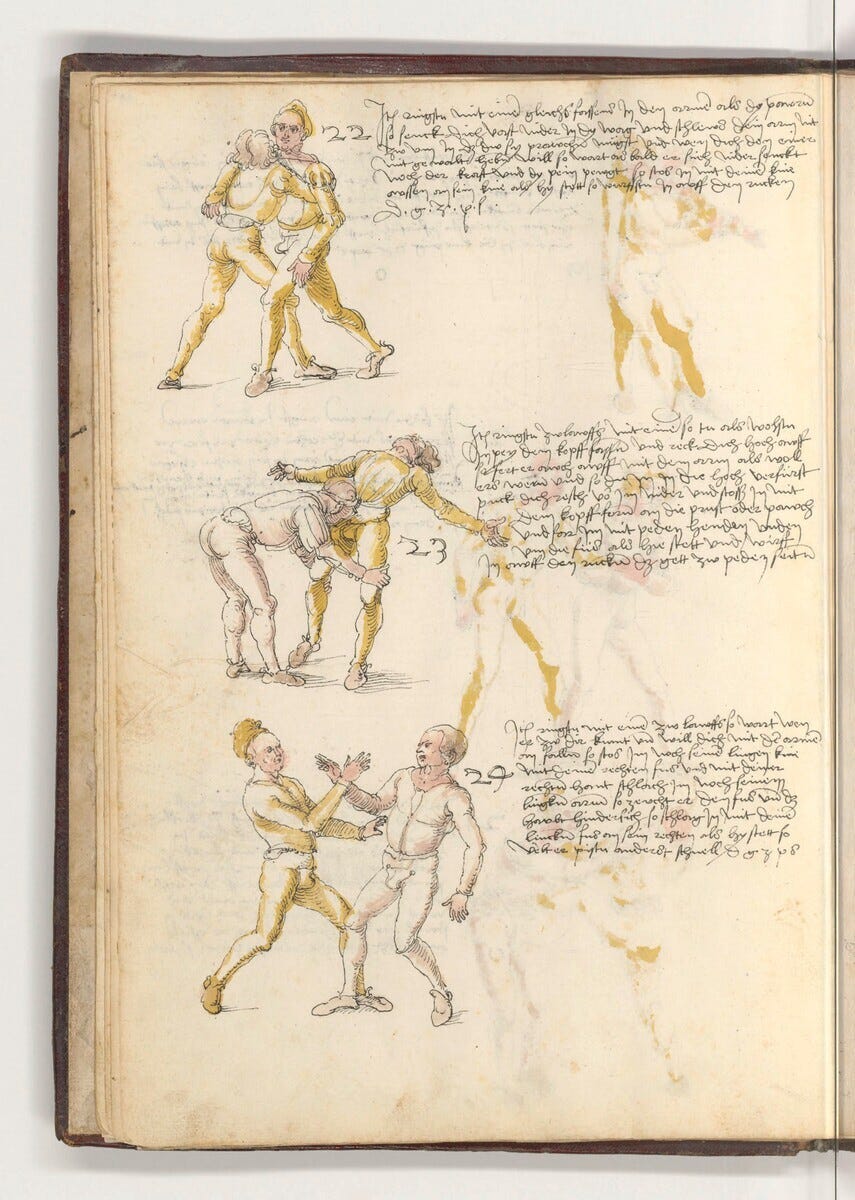Why Democrats Can’t Win Inside the Wrestling Ring
Trumpism, AI, and the Symbolic Collapse That Only Art Can Repair

Did you hear Trump escalated tariffs on China? Or was it Mexico? Or maybe it was Canada? Wait, didn’t he lower tariffs on Mexico last week? Or was that the Heard Island and McDonald Islands? You know, that icy outpost off Antarctica where only penguins live — nasty, nasty penguins. Did you see the mess they make?
If all of this feels chaotic, as if there seems to be no throughline, no grand strategy, no (let’s use a fancy, un-Trumpian Greek word) teleological presence, then you might think this incoherence is politically devastating. Surely, all this flip-flopping undermines Trumpism as a brand?
But that would be a grave misreading of what’s actually happening.
Each escalation, each reversal, each dramatic posturing represents not a policy move or policy failure, but a gesture in a larger drama: moves in the moral theater of Trumpism. Like a professional wrestling match, each action is designed to exist in isolation from all previous and future actions and feel intelligible on their own. There is no arc, no strategy, no synthesis, only scenes that are whole in themselves and complete in their message. Scenes through which the spectators do not seek explanation, but recognition. Scenes in which justice is enacted, enemies are punished, the hero is absolved of wrongdoing, and meaning is delivered not through coherence, but through affect.
But what wrestling is especially supposed to imitate is a purely moral concept, justice. The notion of payment is essential to wrestling, and the crowds ‘Make him suffer’ signifies above all ‘Make him pay.’ What is involved then, of course, is an imminent justice. — Roland Barthes ‘In The Ring’
Americans, after all, have undergone decades of being told they are unique, special, self-made individuals. Each American is responsible for their own fate, and if life is not working out, the problem must be you. And yet, every cultural signal from TikTok videos, Instagram reels, and curated Facebook updates shows everyone else living better. A perfect image of an idealized American life is constantly represented, endlessly reproduced, and algorithmically pushed into your feeds, while your own life feels stagnant, directionless, maybe even collapsing.
You work hard, follow the rules, do what you are told, and still you are falling behind. If such a structure is to persist, reflection itself becomes an existential threat to the system — meaning cannot emerge from critical thought but is instead replaced by algorithmically curated structures of blame, reinforced by a pseudo-Greek Stoicism that naturalizes suffering and reframes it as virtue. These narratives work in tandem with the deeper currents of neoliberalism: if everything is failing despite your compliance, someone must be cheating you out of what you deserve.
For years and years, we’ve suffered with millions of criminals coming into our country. Criminals, people from jails, from all over the world, they come through Mexico, and they come through Canada too. A lot of them come through Canada, and a lot of fentanyl comes through Canada, and China makes the fentanyl.
Am I going to impose tariffs on the European Union? Do you want the truthful answer or should I give you the political answer? Absolutely. Absolutely. The European Union is treating us so terribly. Trump, Jan 31st, 2025.
Truth is not something that matters in the specific form being enacted here. Just like watching a professional wrestling match, we are not concerned with whether the good guy was truly wronged by the bad guy. There is no symbolic activity taking place. What we are presented with is a black-and-white issue, drained of ambiguity. Truth, in such a dichotomy, is irrelevant. What matters is not the content, but the form. The form is the vehicle through which the spectators experience the emotional triumph of justice.
The collapse of symbolic activity into pure signs is the attraction of professional wrestling and the attraction of Trumpism for the majority of Americans. Ambiguity is the enemy of this form. What it offers instead is legibility, emotional clarity, and the satisfaction of immediate moral recognition.
In wrestling, as in Trumpism, nothing exists unless it exists in totality. There are no allusions, no liminal spaces for possible formations. Everything is given exhaustively. Every gesture, every move, every reversal is presented without ambiguity, stripped of interpretive openness.
The classic misstep of Democrats is to go on television or social media and point to a chart, a graph, a dataset — something that shows how things ‘really are,’ which is the supposed truth of the matter. But this is the equivalent of entering a boxing match when what we are in is a wrestling ring. In wrestling, the idea of a fair fight is unintelligible. Referees are not there to arbitrate truth from fiction. They are actors playing a predetermined role in a spectacle.
And don’t get me wrong, unlike professional wrestling, where the outcomes are fantasy, Trumpism is anything but. Its consequences are real. But the form of Trumpism — the structure of how it produces and delivers meaning — is what remains fundamentally misunderstood by Democrats.
A classic approach Democrats take is to situate arguments within a broader narrative, a teleological arc in which justice is gradually realized through measured reform and institutional process. This is the boxing ring metaphor. In a boxing match, the story unfolds through time. The spectators invest not just in the outcome, but in the embodied experience of strategy, risk, and endurance. Meaning arises through narrative, through lived tension, through a shared milieu. There is ambiguity. There is risk. There is the hope of a hard-won victory, but above all we are working together through this uncertain endeavor.
There is no risk in Trumpism. There is only justice.
The medium is the message, Marshall McLuhan famously declared. What he meant is that the form through which a message is delivered becomes more significant than its content.
Trumpism is a semiotic machine. A feedback loop of signs, spectacle, and affective clarity. It delivers the sensation of moral order not through truth, but through structure. Not through ambiguity, but through the certainty of deliverance.
The Heard Island and McDonald Islands? I’m sorry. You’re confused only because you’re standing outside the ring. And as long as you remain there — outside the doors of the spectacle — your objections are mute and moot.

You may be wondering: what can we do, if facts, PowerPoints, and my polynomial regression showing that homelessness is caused by the structural architecture of global finance and not by individual moral failure, do not matter inside this ring?
The answer is to reveal the ring.
You must show that we are all participants in a spectacle and beneath the signs and gestures lies an unspoken ontological condition, one we are unwittingly sustaining.
This is the role of the artists.
An artist defamiliarizes the familiar. Through this process, they reveal the unacknowledged assumptions that make the current ontological formation appear natural, inevitable, or self-evident.
This act of defamiliarization invites reflection. It creates a spatial and temporal opening where signs are reinflated into symbols, and ambiguity becomes a portal to possibility and new creative formations.
This is the generative, that generative AI seeks to foreclose.

Buried in the latest GOP tax bill, released in step with Trump’s legislative agenda, is a 10-year federal ban on state-level AI regulations. Why would the party of ‘small government’ seek to override the autonomy of states for a decade by consolidating authority in the name of innovation?
Let’s step back into the wrestling ring.
As I write this, President Trump is having lunch in Riyadh with some of the most powerful business leaders in the world. Among them are Elon Musk, Sam Altman, Jensen Huang, Ruth Porat, Andy Jassy, and a long list of executives from Amazon, Google, Nvidia, BlackRock, Citigroup, and Palantir — representatives of four of the ten largest U.S. companies by market value. The official agenda covers investment, technology partnerships, and trade policy with Saudi officials. Yet beneath this diplomatic formality there is something that is much more profound: a rapid crystallization of a metaphysical realignment that has, until now, been a slow-moving and largely subterranean project whose origins trace back to the mid-16th century. In fact, I can give you an exact date: 1543.
That was the year Nicolaus Copernicus published De revolutionibus orbium coelestium (On the Revolutions of the Heavenly Spheres), a work that punctured a hole in the cosmological order of the West and helped set into motion the emergence of the modern, alienated subject.
Before this rupture, one’s place in the cosmos was not separate from one’s place in society. Social and spiritual roles were embedded within a divinely ordered, hierarchical universe — an ontological chain of being stretching from the lowliest peasant to the angels, and ultimately to God. Life was not about individual expression or economic self-determination, but enacting one’s ordained role in accordance with that cosmic structure. Meaning came from alignment with this order, not departure from it. A good life was not something to be sought or debated as it was already laid out for you. The very concept of what a good life is would be incoherent in this cosmological frame.
Now that Copernicus punctured the snowglobe, the inhabitants were no longer held within a symbolically rich cosmological embrace. Out rushed this mixture of symbols, intimate rhythmic and melodic gestures, the harmonic order of the great chain of being of which one’s resonance was assured, and in rushed a catastrophically silencing void.
Orientation was no longer ontological, but optical. We no longer belonged — we merely observed. And so Plato’s cave metaphor regained its relevance. Once again, we found ourselves staring at shadows on a wall, mistaking abstraction for presence, image for truth.
Observation, calculation, quantification, collection, data. This is what we chose to fill the void with. In the absence of resonance, we turned to representation. In the silence left behind by the Copernican revolution, we built instruments, models, and systems that could simulate meaning. These were structures that offered the appearance of coherence, but without participation and without relation. For all its clarity, data is not presence. But it can be summoned to suture the hole that was punctured into the cosmological order 482 years ago.
AI and Trumpism are completely legible within this wrestling ring.
We’ve already established the logics of Trumpism’s form — its reliance on affective clarity, moral theater, and gestures which are logically complete within themselves. AI, however, is more amorphous. It has been called many things: a tool (which it is not), a personal assistant, a universal solver, artistic muse, the list goes on depending on how desperate the speaker is for investment. but none of these names account for what AI actually is: an ontological engine that flattens the symbolic, forecloses ambiguity, and through that foreclosing replaces the limitlessness of human potential with the predictive rearrangement of what has already been.
AI does not reason, nor does it imagine. It does not participate in the world, nor does it understand meaning. Its inability to generate data on its own is not a minor limitation — it is its defining ontological condition. AI relies on a tether to human beings, who do participate, who do suffer, reflect, choose, and act in time. But in order for AI to appear legible within a participatory, open-ended world, it must narrow the field. It must define the limits of action, perception, and imagination — through us.
This narrowing is achieved through a transformation already underway: the imposition of the wrestling ring as cultural form.
The past has always been present in the present. It acts upon our choices, frames our interpretations, and pulls forward the future in ways that make it legible. This dynamic — past acting upon the present to produce the future — is where agency resides. It is also where modern anxiety lives: the open field of contingency, of not knowing what will come or how we will respond.
Historically, the past was not a static record but a generative force. It enveloped us like a sphere — shaping meaning, embedding us in ritual, echoing through symbolic forms. But with the puncturing of the cosmological order in 1543, that past was no longer circumscribed. It was loosed from the symbolic enclosure and laid flat onto a linear plane.
Since then, this plane has stretched beneath our feet. We walk atop it, facing forward, but always tethered to what came before. It is no longer a resonant chamber but a timeline something we progress from. This linear history renders us vulnerable because it implies forward movement without guarantee, and repetition without return.
AI now enters the picture as an attempt to reinscribe a virtual circumscription. In a reverse Copernican move, history is lifted from beneath our feet and placed around us — covering the cosmic rupture with a totalizing structure. Built from the assimilation of vast repositories of human-produced data, this structure is unlike the old cosmological sphere as this new enclosure does not resonate, embrace or orient. It merely contains.
Now the wrestling ring has gone from the cultural container of Trumpism to global cosmological order, which for the first time in nearly 500 years provides those who opt into its enclosure with the semblance of certainty in an uncertain universe. It delivers presence without participation, coherence without contingency, and meaning without futurity. It offers a unified world in which every gesture is legible and total, every outcome anticipated, and every symbol transformed into a sign flattened into pure spectacle. And above all it loosens the limits of capital tied to material configurations, enabling the unrestricted circulation, and therefore multiplication, of its accumulative power.

Artists stand at this threshold as our essential navigators. Not because they can restore the broken snowglobe or rebuild the lost cosmological order, but because they can reveal what both the wrestling ring and the algorithm seek to conceal: the generative power of uncertainty itself.
Art doesn’t resolve ambiguity — it inhabits it.
Art doesn’t flatten symbols into signs — it reinflates signs back into symbols.
Through defamiliarization, art creates precisely what the political-technological alliance seeks to eliminate: the spaces where we recognize our participation in shaping meaning, rather than merely consuming its simulation.
The artist reveals not just the ring, but the possibility of stepping outside it. Not only the enclosure, but what may lay beyond it. In that revelation of the possible, we glimpse what is most real: our capacity to participate in a world whose meaning is neither predetermined by cosmic order nor generated by algorithmic recursion, but created through symbolic risk, temporal tension, and necessary frictive embodied engagement with the unknown.
This is why art is not a luxury in our moment. And why art, in its complete uselessness, becomes an absolute necessity.



